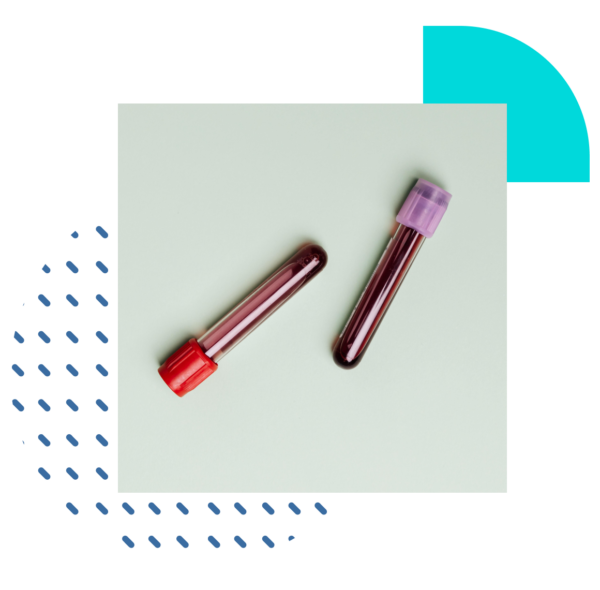An allergy is a protective reaction of the human immune system to substances that are actually harmless, such as pollen, dust or food. The more sensitive the immune system reacts to the allergen, the more severe the symptoms. Allergies can cause watery or red eyes, sneezing, runny nose, itching or an upset stomach.
Rarely, an allergic reaction can also cause anaphylaxis. This causes the airways to constrict, leading to severe shortness of breath and a sharp drop in blood pressure. Without immediate treatment, such a shock can be fatal.
Various tests can be carried out to find out which substance triggers an allergic reaction: Skin tests, blood tests and so-called irritation tests. A suitable allergy test can usually be found in the doctor’s surgery as a result of a description of symptoms and medical history.

Skin tests can be carried out quickly and easily, which is why they are often the first line of diagnosis. In a skin test, possible allergens are applied to the skin and the reaction is monitored. This usually occurs on the underside of the forearm, sometimes also on the back.
The English word “prick” means “puncture”. Many people have probably heard the term, as this is the most commonly used allergy test. But what exactly is a prick test? The term comes from the English verb “to prick”, which means “to pierce” and thus describes an important part of the execution.
During a skin examination, the doctor examines various allergens or the patient’s reaction to them. In such a test, the doctor applies an aqueous solution containing an allergen such as pollen or traces of animal hair to marked areas of skin. The skin is lightly scratched with a lancet so that the allergens can penetrate.
This allergy test can detect immediate reactions, which is why it makes sense to suspect so-called immediate allergies, i.e. physical reactions that start within a few minutes. There is a standard range for skin tests that includes around 15-20 solutions with the most common allergens. Doctors always carry out so-called positive and negative controls in order to be able to better assess the results of other solutions.
The active control is a saline solution to which the patient should not react. If this is the case, the skin can generally overreact.
The negative control in the skin test is histamine. An obvious reaction, such as the formation of nodules, is not a sign of an allergy, but is desirable. These two solutions ensure that the results of the Sting test can be evaluated, or more precisely, used.
Importantly, prick tests can be used to detect allergies where the cause of a reaction occurs immediately after exposure – such as hay fever or certain food allergies.
The effect of the intradermal test is similar to that of the skin test. This means that the affected person is exposed to the allergen.
The difference, however, is that the doctor injects the allergen into the skin (intradermal injection) instead of just applying it superficially to the skin. This test can therefore also detect weaker allergic reactions.
Such an allergy test is usually only used if the previous skin test has not provided suitable results. This is because the injection is usually more irritating for those affected and the allergic reaction is correspondingly stronger.
As this test is somewhat more unpleasant, as the injections go directly under the skin and can also cause a stronger allergic reaction, it is only recommended if the prick test does not show a corresponding reaction.
If the results of the prick test are not clear enough, the scratch test can also be used in addition to the intradermal test.
“Scratch” is the English word for “scratch” – and with this allergy test, the name says it all. The doctor scratches the surface of the skin (but does not make the sample bleed) and rubs the suspected allergen onto the skin at this point. This friction allows the relevant allergens to penetrate deeper into the tissue, which is why this allergy test is often used as an option when a skin test does not produce any results.
However, with such a test it is not possible to control the amount of allergens that actually enter the body. For this reason, and because this test is relatively insensitive, its significance is limited.
However, it is suitable for liquids and water-soluble substances, such as food or drug allergy tests. If the affected person has an allergic reaction, redness and swelling occur within about 20 minutes.
The friction test is used if a severe allergic reaction is suspected. The test substance is rubbed onto the skin and the test is read after about 20 minutes. The scratch test is more sensitive than the rub test. The substance is applied to the skin and the skin surface is scratched. Here too, the allergic reaction sets in after about 20 minutes.
For this allergy test, your doctor will stick a plaster containing the test substance to your skin so that the skin remains intact during the allergy test and does not need to be scratched.
With these patches, doctors can apply up to 4,000 potential allergens to the back or inside of the forearm – not all at once, of course. Usually, the doctor first examines the so-called standard series, i.e. the 27 substances listed in the test series of the German Dermatological Society that most frequently trigger allergies.
After 20 minutes, the doctor first checks whether there is a reaction under the test patches. Two follow-up checks after 24 hours confirm or deny the result. The patch will then be evaluated, i.e. your doctor will check whether and to what extent poplars, blisters and other allergic reactions have formed under the patches.
Which allergens can be detected with this allergy test? Allergens that trigger so-called late type reactions. In other words, if an allergy is suspected and the symptoms only appear hours or days after contact with the allergen, a doctor will usually carry out a skin test.
Which substances are usually tested?
Your doctor can diagnose allergies with a blood test. This means that the doctor takes blood from the person concerned and sends it to a laboratory for testing. The staff then check how many specific IgE antibodies are detectable there. The term IgE stands for “immunoglobin E” and refers to proteins that the body produces in response to or to prevent allergies.
A blood test is an option if the person concerned has a skin condition that could affect the skin test, or if the skin test is too stressful, e.g. due to other serious allergies. Food allergies can be detected by blood tests, but they also provide information if an allergy to pollen, house dust mites, animal hair or medication is suspected.
Although a doctor has to draw blood for this test, some people find it more comfortable than a skin test, for example, because it does not expose the body to allergens.
However, blood tests can only determine the cause of an allergy, as the body produces specific antibodies depending on the allergen.
However, conclusions about the severity and type of allergy symptoms cannot be drawn from an allergy test with blood tests. The cost of such a test varies, but is usually covered by health insurance.

This term refers to an allergy test in which the doctor applies an allergen to the affected person’s mucous membranes, where the symptoms mainly manifest themselves. Stimulus tests may indicate an allergy if other tests are inconclusive or inconclusive. And it is the only method that can also detect non-allergic hypersensitivity reactions (e.g. intolerances).
In this procedure, the doctor applies a suspected allergen to the mucous membranes. This occurs either directly (e.g. on the nasal mucosa or conjunctiva) or by inhalation by the patient or – in the case of food or drug allergies – by ingestion (orally). Then you have to wait and see (under medical supervision!) whether and how the body reacts.
Even if no acute allergy symptoms are noticeable immediately before the provocation, a doctor must be prepared for skin tests and in particular irritation tests so that he can react quickly to possible severe allergic reactions.
What do I need to bear in mind? Finding an allergen is a step-by-step process: after consulting a doctor, a skin test is usually carried out first. Blood tests are used when a skin test is difficult or too risky. In addition, some allergens are not available as ready-to-use solutions for skin tests. A provocation test only makes sense if a skin test or blood test does not provide a clear result.
A skin test is also important to tell your doctor if you have a lung disease, skin disease or heart problems. The same applies if you are taking medication that can affect skin reactions, such as the antibiotics amoxicillin or penicillin or painkillers such as ASA or ibuprofen.
The doctor treating you will decide which type of allergy test makes the most sense for you.

Choose a suitable health test from our wide range and book it in just a few clicks via our website.
Find a partner in your area or choose a home test kit to easily draw blood from your finger.
Your result will automatically appear in your personal health portal. Including explanations and timelines.